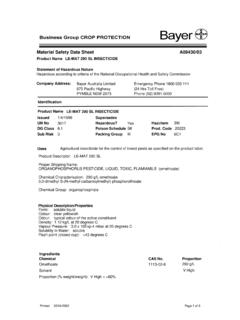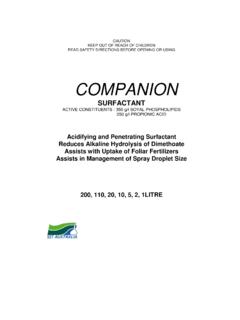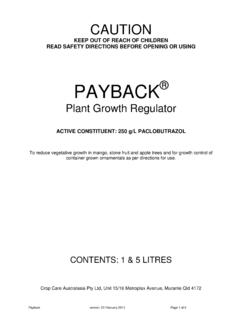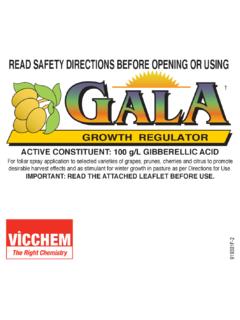Transcription of Material Safety Data Sheet - DKT
1 Material Safety data Sheet Lorsban 500 EC insecticide Hazardous according to the criteria of the National Occupational Health & Safety Commission (NOHSC). Risk Phrases: R20 Harmful by inhalation, R22 Harmful if swallowed, R36 Irritating to eyes, R65 Harmful: May cause lung damage if swallowed. Date of Issue: February 2001. Page: 1 of 4. Company: Dow AgroSciences Australia Ltd, ABN 24 003 771 659. Address: Level 5, 20 Rodborough Road, Frenchs Forest NSW 2086. Website: Customer Service Toll Free Number: 1800 700 096 (Mon-Fri, 8am 5pm EST). Emergency Telephone Number: 1800 033 882 (24 hours) (EMERGENCIES ONLY). IDENTIFICATION. Product Name: Lorsban 500 EC insecticide Shipping Name: ORGANOPHOSPHORUS PESTICIDE, LIQUID, TOXIC. Product Code: IWD 4326. UN No: 3018. Hazchem Code: 2X. Dangerous Goods Class: 61 Toxic Substances Sub Risk Class: None allocated Packaging Group: III Most EPGs may now be substituted by the Initial Emergency Response Guide, available from Standards Australia Poison Schedule: S6.
2 Uses: For the control of certain insect pests in fruit, vegetables, field crops, pasture and other situations as specified on the label PHYSICAL APPEARANCE & PROPERTIES. Appearance: Clear, amber liquid Boiling point: 183oC (solvent). Volatile materials: No specific data , expected to be low at 100oC. Flashpoint: 67oC (PMCC). Specific gravity: 1075 g/mL @ 20oC. Solubility in water: Emulsifiable Corrosiveness: Not corrosive Vapour Pressure: 26 mm Hg at 38oC (solvent), 187 x 10-5 mm Hg at 25oC. (chlorpyrifos). INGREDIENTS. Chemical Entity CAS No. Proportion Chlorpyrifos 002921-88-2 500 g/L. Aromatic solvent 064742-94-5 400 g/L. Petroleum solvent < 100 g/L. Other non hazardous ingredients < 100 g/L.. Trademark of Dow AgroSciences Dow AgroSciences Australia Limited Lorsban 500 EC insecticide Page 1 of 4. February 2001. HEALTH HAZARD data . HEALTH EFFECTS. The active ingredient in Lorsban 500 EC is the organophosphate compound chlorpyrifos. Excessive exposure may cause organophosphate type cholinesterase inhibition.
3 Symptoms of excessive exposure to chlorpyrifos may include pallor, nausea, vomiting, diarrhea, abdominal cramps, headache, dizziness, eye pain, blurred vision, constriction or dilation of the eye pupils, tears, salivation, sweating, and confusion. The information provided below is from studies conducted with a formulation similar to Lorsban 500EC. Acute Swallowed: The oral LD50 (rat) is 230 to 310 mg/kg (moderately toxic). Eye: Will cause temporary, moderate eye irritation. Skin: The dermal LD50 (rabbit) is above 2000 mg/kg. Toxicity is low and less than 3% of applied is absorbed. Prolonged contact may result in absorption of harmful amounts. Inhaled: The inhalation LC50(rat) is 2000 to 2400 mg/m3 for 4 hours exposure (moderate to low toxicity). Excessive exposure to spray mist may be harmful. Prolonged exposure to solvent vapour from the concentrate may cause eye and respiratory tract irritation, headache, dizziness and narcotic effects. Chronic Possible chronic health effects from exposure to Lorsban 500 EC are based on studies using the active ingredient.
4 Chlorpyrifos has been shown not to cause cancer and does not interfere with reproduction and does not cause genetic damage or birth defects. Chlorpyrifos is rapidly metabolised and excreted, and as a result, does not accumulate in the body. Repeated minor exposure may have a cumulative poisoning effect. The ingredients are not listed as carcinogenic in NOHSC's document Exposure Standards for Atmospheric Contaminants in the Occupational Environment (May 1995). PERSONAL PROTECTION AND Safety DIRECTIONS. Product is poisonous if absorbed by skin contact, inhaled or swallowed. Repeated minor exposure may have a cumulative poisoning effect. Obtain an emergency supply of atropine tablets mg. Will irritate eyes and skin. Avoid contact with eyes and skin. Avoid inhaling spray mist. When opening the container, preparing the spray or bait, or using the prepared spray or bait, wear cotton overalls buttoned to the neck and wrist and a washable hat, elbow-length PVC gloves, face shield or goggles.
5 If product on skin, immediately wash area with soap and water. After use and before eating, drinking or smoking, wash hands, arms and face thoroughly with soap and water. After each day's use wash gloves, face shield or goggles and contaminated clothing. FIRST AID. General: Consult The National Poisons Information Centre (Ph: 13 11 26) or a Doctor in every case of suspected chemical poisoning. Never give fluids or induce vomiting if a patient is unconscious or convulsing regardless of cause of injury. If breathing difficulties occur seek medical attention immediately. Atropine tablets should be available in the area where this product is used, or in a nearby unlocked medicine cabinet. Swallowed: If swallowed, give one atropine tablet every 5 minutes until dryness of the mouth occurs. Get to a doctor or hospital quickly. Skin: If poisoned by skin absorption or through lungs, remove any contaminated clothing and wash skin thoroughly and give one atropine tablet every 5 minutes until dryness of the mouth occurs.
6 If Safety shower is available, use it promptly. Get to a doctor or hospital quickly. Eyes: If in eyes, hold eyes open and flood with water for at least 15 minutes and see a doctor. Ensure irrigation under eyelids by occasionally lifting them. Do not try to remove contact lenses unless trained. Inhalation: If affected, remove from contaminated area to fresh air. If breathing is difficult give oxygen and if necessary artificial respiration. Get to a doctor or hospital quickly. Advice to Doctor: Chlorpyrifos is a cholinesterase inhibitor. Atropine by injection or ATROVENT/ipratropium by airway puff are the preferred antidotes. Oximes such as 2 PAM/ protopam, may be therapeutic if used early but only if used in conjunction with atropine. Lorsban 500 EC contains petroleum- like solvents. If lavage is performed endotracheal or oesophagioscopic control is advisable. Dow AgroSciences Australia Limited Lorsban 500 EC insecticide Page 2 of 4. February 2001. PRECAUTIONS FOR USE.
7 EXPOSURE STANDARDS. A time weighted average (TWA) has been established for chlorpyrifos of The corresponding STEL level is "not set". The exposure value at the TWA is the average airborne concentration of a particular substance when calculated over a normal 8 hour working day for a 5 day working week. The ADI (Acceptable Daily Intake) for chlorpyrifos is set at The corresponding NOEL (No-observable-effect-level) is set at Values taken from Australian ADI List, January, 2001. ENGINEERING CONTROLS. In industrial situations, concentrated values below the TWA value should be maintained. Values may be reduced by process modification, use of local exhaust ventilation, capturing substances at the source, or other methods. If you believe airborne concentrations of mists, dusts or vapours are high, you are advised to modify the process or environment to reduce the problem. SAFE HANDLING INFORMATION. This product is classified as a C1 combustible product. STORAGE & TRANSPORT.
8 This product is classed as UN3018, ORGANOPHOSPHORUS PESTICIDE, LIQUID, TOXIC, Dangerous Goods Class Toxic Substances, Packaging Group III, HAZCHEM 2X. Class 6 Toxic Substances shall not be loaded in the same vehicle or packed in the same freight container with Classes 1 (Explosives), 3 (Flammable Liquids where the Flammable Liquid is nitromethane), (Oxidising Agents where the Toxic Substances are Fire Risk Substances), (Organic Peroxides where the Toxic Substances are Fire Risk Substances), 8 (Corrosive Substances where the Toxic Substances are cyanides and the Corrosives are acids), Foodstuffs and foodstuff empties. They may however be loaded in the same vehicle or packed in the same freight container with Classes, (Flammable Gases), (Non-Flammable, Non-Toxic Gases), (Toxic Gases), 3 (Flammable liquids, except where the flammable liquid is nitromethane), (Flammable Solids), (Spontaneously Combustible Substances), (Dangerous When Wet Substances), (Oxidising Agents except where the Toxic Substances are Fire Risk Substances), (Organic Peroxides except where the Toxic Substances are Fire Risk Substances), 7 (Radioactive Substances), 8 (Corrosive Substances except where the Toxic Substances are cyanides and the Corrosives are acids), 9 (Miscellaneous Dangerous Goods).
9 This product is an S6 Poison. Observe all relevant regulations regarding sale, transport and storage of this class of product. Store in tightly closed original containers in a cool, well-ventilated area, out of direct sunlight. Do not store with food, feedstuffs, fertilisers or seeds. SPILLS. Wear protective equipment (see PERSONAL PROTECTION). Clear area of all unprotected personnel. Prevent entry of chemical or used/damaged containers into drains, streams or waterways. Small Spill: Apply absorbent Material such as earth, sand, clay granules or cat litter to the spill. Sweep up Material when absorption is completed and contain in a refuse vessel for disposal (see DISPOSAL). If spilled inside a building wash contaminated surfaces to deactivate the chlorpyrifos with a solution of bleach (sodium hypochlorite) prepared according to the bleach label instructions. Large Spill: Place leaking containers into salvage drums. Apply absorbent Material such as earth, sand or cat litter to the spill area.
10 Form a barricade around spill and in front of drains or waterways in spill vicinity, using earth or other available Material . Sweep up Material and contain in a refuse vessel for disposal (see DISPOSAL). Contact Emergency Services on 000 immediately and notify Dow AgroSciences Australia Limited on 1800 033 882 (24 hours) or 1800 700 096 (Mon-Fri, 8am to 5pm EST). DISPOSAL. Contaminated Material must be disposed of in accordance with all State and/or Local regulations. Small quantities and containers: Triple or preferably pressure rinse containers before disposal. Add rinsings to spray tank. Do not dispose of undiluted chemicals on site. If recycling container, replace cap and return clean containers to Dow AgroSciences Australia Limited Lorsban 500 EC insecticide Page 3 of 4. February 2001. recycler or designated collection point. If not recycling break, crush, or puncture and bury empty containers in a local authority landfill. If no landfill is available, bury the containers below 500 mm in a disposal pit specifically marked and set up for this purpose clear of waterways, desirable vegetation and tree roots.












